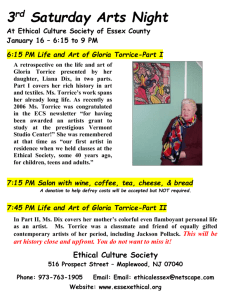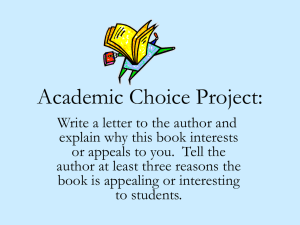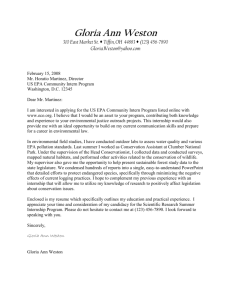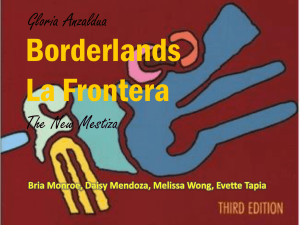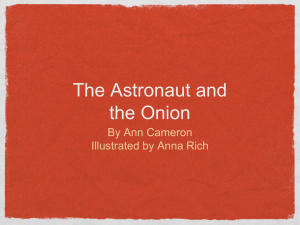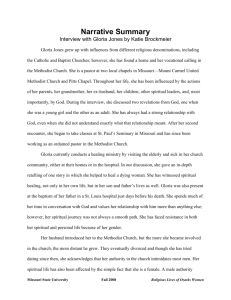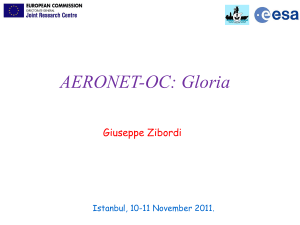1st Grade Community Helpers Thematic Unit
advertisement
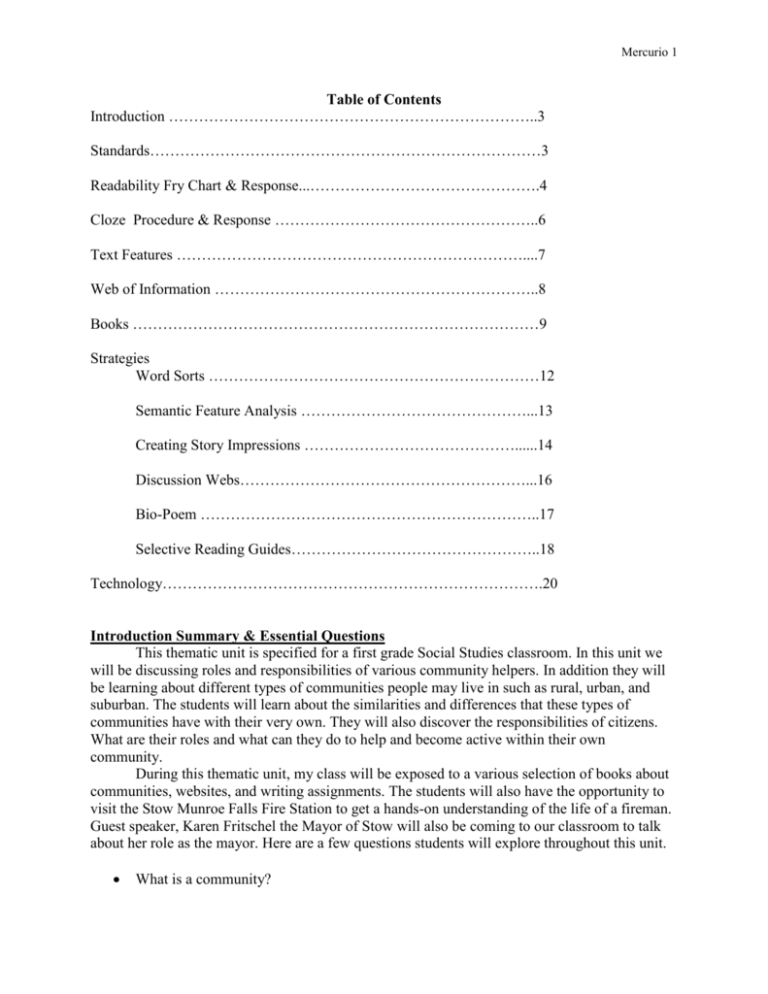
Mercurio 1 Table of Contents Introduction ………………………………………………………………..3 Standards……………………………………………………………………3 Readability Fry Chart & Response...……………………………………….4 Cloze Procedure & Response ……………………………………………..6 Text Features ……………………………………………………………....7 Web of Information ………………………………………………………..8 Books ………………………………………………………………………9 Strategies Word Sorts …………………………………………………………12 Semantic Feature Analysis ………………………………………...13 Creating Story Impressions ……………………………………......14 Discussion Webs…………………………………………………...16 Bio-Poem …………………………………………………………..17 Selective Reading Guides…………………………………………..18 Technology………………………………………………………………….20 Introduction Summary & Essential Questions This thematic unit is specified for a first grade Social Studies classroom. In this unit we will be discussing roles and responsibilities of various community helpers. In addition they will be learning about different types of communities people may live in such as rural, urban, and suburban. The students will learn about the similarities and differences that these types of communities have with their very own. They will also discover the responsibilities of citizens. What are their roles and what can they do to help and become active within their own community. During this thematic unit, my class will be exposed to a various selection of books about communities, websites, and writing assignments. The students will also have the opportunity to visit the Stow Munroe Falls Fire Station to get a hands-on understanding of the life of a fireman. Guest speaker, Karen Fritschel the Mayor of Stow will also be coming to our classroom to talk about her role as the mayor. Here are a few questions students will explore throughout this unit. What is a community? Mercurio 2 Can you name the three types of communities? (Rural, urban, and suburban) What is a community helper? Can you name 5 community helpers? Can you name 4 of their roles and responsibilities? Ohio Standards for the Unit Content, Reading and Technology Social Studies: People in Societies (K-2) Benchmark A: Identify practices and products of diverse cultures. 1. Identify ways that individuals in the family, school and community are unique and ways that they are the same. Social Studies: Geography (K-2) Benchmark A: Identify the location of the state of Ohio, the United States, the continents, and oceans on maps, globes and other geographic representations. 6. Describe the immediate surroundings of home (e.g.,streets, buildings, fields, woods or lakes). Social Studies: Government (K-2) Benchmark A: Identify elected leaders and authority figures in the home, school, and community and explain reasons for having persons in authority. 3. Identify purposes for having rules and ways that they provide order, security and safety in the home, school and community. Technology: Technology and Information Literacy (K-2) Benchmark A: State what information is, and show where it can be found. 2. Use a graphic organizer to sort information Technology: Technology for Productivity Applications (K-2) Benchmark A: Understand basic computer and multimedia technology concepts and terminology 1. Identify and use computer and multimedia technology and know the terms used to describe it (e.g., computer, printer, VCR, DVD player, audio players). English Language Arts: Reading Process: Concepts of Print, Comprehension Strategies and Self-Monitoring Strategies (K-3) Benchmark E: Demonstrate comprehension by responding to questions (e.g., literal, informational and evaluative). 3. Visualize the information in texts and demonstrate this by drawing pictures, discussing images in texts or writing simple descriptions. 4. Make predictions while reading and support predictions with information from the text or prior experience. 7. Create and use graphic organizers such as Venn diagrams or webs, with teacher assistance, to demonstrate comprehension. English Language Arts: Reading Applications: Informational. Technical and Persuasive Text (K-3) Mercurio 3 Benchmark D: Use visual aids as sources to gain additional information from text. 3. Ask questions concerning essential elements of informational text (e.g., why, who, where, what, when and how). English Language Arts: Acquisition of Vocabulary (K-3) Benchmark A: Use context clues to determine the meaning of new vocabulary. 1. Use knowledge of word order and in-sentence context clues to support word identification and to define unknown words while reading. 6. Predict the meaning of compound words using knowledge of individual words (e.g., daydream, raindrop). English Language Arts: Writing Applications (K-2) Benchmark B: Write responses to literature that demonstrate an understanding of a literary work. 3. Write friendly letters or invitations that follow a simple letter format. English Language Arts: Research (K-2) Benchmark B: Retell important details and findings. 4. Recall important information about a topic with teacher assistance. Readability: Fry Chart & Response Rathmann, P. (1995). Officer Buckle and Gloria. New York: Putnam's. Word Count Page Numbers Number of Sentences Number of Syllables Beginning 100 1-4 10.4 154 Middle 100 10-13 11.2 148 End 100 19-24 12.7 155 Average 100 - 11.4 152.3 According to the collected data above, the students reading this book will have a difficulty decoding and understanding material due to the average length of words. On the Fry Graph it was placed at the seventh grade reading level. For a first grade lesson plan, I would read Officer Buckle and Gloria as a classroom read aloud. Since the average lengths of words used Mercurio 4 throughout this book are long, I can engage the kids in some activities dealing with vocabulary before reading the book. Some words they might interact with are command, enormous, department, expression, auditorium, electrical, bulletin board, and obey. As a way to have the students engaging with the words, I can have them create their own sentence using the vocabulary term but when they read their sentence aloud to the class, they will say “blank” instead of the term. After they read the sentence aloud with the missing term, someone else in the class can try and guess what the vocabulary term their classmate was using. Another activity I can use to engage the students with vocabulary is by having them create their own dictionaries. They can take a piece of construction paper and fold it in half. On the front of it they can create their own book cover for Officer Buckle and Gloria. After they created a cover they can insert paper and being writing unfamiliar words in their dictionary. Together as a class we can try and come up with a good definition we all agree on. The point of this activity is to discuss the vocabulary words. Listen to the students to see what they already know or do not know about the terminology and also to get them familiar with both dictionaries and glossaries. Lastly, as a teacher I can show the students how to break up words to find help them define a meaning. For example, with the word “thumbtack” I can show them how to break the word into two parts such as “thumb” and “tack”. I would then explain that tack means to attach or fasten, so when you put the words together a thumbtack is a tack that can be pushed with your thumb into a bulletin board to hold items such as papers. Each of these strategies will help the students understand and comprehend the material and vocabulary used in this book. Cloze Procedure Mercurio 5 Officer Buckle and Gloria Cloze Procedure Name: ____________________ Date: __________ auditorium applaud discovered expression imagination thumbtacked enormous electrical obeys 1. Every time he thought of a new one, he ______ it to his bulletin board. 2. “Gloria ______ my commands. Gloria, SIT!” 3. He said the rest of the tips with plenty of ______. The children clapped their hands and cheered. 4. The next day, an ______ envelope arrived at the police station. 5. Officer Buckle thought the drawings showed a lot of______. 6. Then one day, a television news team videotaped Officer Buckle in the state-college ______. 7. When he finished Safety Tip number ninety-nine, do not go swimming during ______ storms!, the students jumped to their feet and ______. “Bravo! Bravo! Bravo!” 8. Officer Buckle thought of a safety tip he had ______that morning. Answer Key 1. Every time he thought of a new one, he thumbtacked it to his bulletin board. 2. “Gloria obeys my commands. Gloria, SIT!” 3. He said the rest of the tips with plenty of expression. The children clapped their hands and cheered. 4. The next day, an enormous envelope arrived at the police station. 5. Officer Buckle thought the drawings showed a lot of imagination. 6. Then one day, a television news team videotaped Officer Buckle in the state-college auditorium. 7. When he finished Safety Tip number ninety-nine, do not go swimming during electrical storms!, the students jumped to their feet and applaud. “Bravo! Bravo! Bravo!” 8. Officer Buckle thought of a safety tip he had discovered that morning. Explanation on how it will be adapted in class: I plan on using this cloze procedure assignment in my first grade classroom on a Community Helpers Unit. With this assignment, I can easily adapt it to the lesson by using it as a vocabulary assessment. According to the results of the Fry Graph, my students may have a difficult time decoding the comprehension due to the average length of words. By adapting this assignment prior to reading Officer Buckle and Gloria aloud to the class, engaging in class discussion using appropriate vocabulary terms, and completing a graphic organizer, the students should then be able to complete this assignment. Since this worksheet has lengthy words like as Mercurio 6 the Fry Graph stated, I would not use this assignment until the very end of the unit that way they can interact with the words for a few days verbally and work their way up to visually applying them in sentences. I also plan on reading this assignment aloud to the class just as I read the book aloud. Text Features Officer Buckle and Gloria has the following text features: Illustrations Print Dialogue Illustrations The illustrations can help the students create mental images of the text. Often times struggling readers find it difficult imagining characters or events while reading, so illustrations can help guide that process. Both author and illustrator, Peggy Rathmann, created beautiful detailed illustrations to help guide the text throughout the story. With the illustrations given we can discuss the character’s emotions based on their facial expressions and body language. A good example of this is on the title page of this book. I could ask the students, “What is Officer Buckle doing?” or “How do you think he feels?” Overall, illustrations are a great source of visual aids. Print The print its self in the book is just as important as the illustrations. Having the students see letters formed into words, and words formed into complete sentences is important for not only the aspect of reading but also writing. More importantly they visualize proper grammar usage and punctuation. As a teacher, I can discuss what quotation marks are and how to fluctuate my voice while reading. This would be a great book to model this strategy. Dialogue Dialogue is used very frequently throughout this book. As stated above, I can discuss what quotation marks are and how to use them. I can model what it sounds like when you use dialogue properly by fluctuating your voice according to character and emotions. Dialogue is great because it heightens the text within a story. Officer Buckle and Gloria does not have the following text features: Bolded vocabulary words Glossary Bolded vocabulary words This book does not display bolded vocabulary words but the students can still incorporate their own. In the story there are several words or terms that could be unknown to some students such as obey, command, thumbtack, and auditorium. Although the vocabulary words do not stand out, they are still there and it is up to the students and teacher to depict them. Students can add the words to their handmade dictionary or they can create a separate one for this particular Mercurio 7 book. Having the students just write the term with a definition is boring and most likely they will not remember it but if you give the process meaning by having them choose the words and create their own dictionary could be more engaging. Glossary Even though there is not a glossary in the back the students can create their own. They can choose the words they are having difficulty with and write them on construction paper so it stands out and then place the sheet of paper in the back of the book for their own reference. Getting students familiar with glossaries are important so they can get into a habit of checking later on in their academics. Web of Information Sources: Community Resource: Videos: Who are people in your neighborhood? http://www.youtube.com/watch ?v=__T933kP0Bw Song: People in your Neighborhood http://www.youtube.com/watch ?v=2lRBtfYbNv8&feature=rela ted Stow Police Station located at 3800 Darrow Rd. Stow, Oh. 44224 Stow Fire Department located at 3760 Darrow Rd. Stow, Oh. 44224 Fiction Book: Officer Buckle and Gloria by Peggy Rathmann The Busiest Street in Town by Mara Rockliff City I Love by Lee Bennett Hopkins US Post Office located at 3900 Darrow Road, Stow Guest Speaker: Website for Students: Community Club: http://teacher.scholastic.co m/commclub/index.htm Interactive Street Map: http://bensguide.gpo.gov/k 2/neighborhood/index.htm l Community Helpers Interactive Map: http://www.eduplace.com/ kids/socsci/books/applicati ons/imaps/maps/g3_u1/ind ex.html Reference Resource: Non-fiction book: Board Game: 5 Books Who Am I?-Community Helpers , by Rosie Simms http://www.pcieducation.c om/store/item.aspx?ItemId Fiction, Non- Fiction =41663 Karen Fritschel the Mayor of Stow. She is coming to the class to discuss the responsibilities of a mayor and how citizens can help their community. Postal Workers by Paulette Bourgeois In My Neighborhood Police Officers by Paulette Bourgeois Farming by Gail Gibbons and Poetry Community Helpers Resource: http://teacher.scholastic.com/less onrepro/k_2theme/communities. htm l Mercurio 8 1. Postal Workers by Paulette Bourgeois (Nonfiction) Bourgeois, P., (1992). Postal workers. Tonawanda, New York: Kids Can Press. Gordon’s grandma has a birthday in four days and he wants to mail her a birthday card. He is really nervous about it arriving on time since it has to go from Canada to the United States. In the book, it explains each step of what happens from the moment mail is placed in the mail box. First, Gordon has to purchase a stamp before he puts it in the mailbox. Once it is placed in the mailbox, the postal worker pick up the mail and places it into a local mailbox. Next, a driver comes and picks up and drops off the mail to be sorted by both machines and workers. As they discuss how mail is sorted they also discuss why mail is sorted by describing the difference between postal and zip codes. They differentiate how Canada uses postal codes, while the United States adapted zip codes and the representation of the numbers can allow the postal worker to locate where it needs to be taken. After all of the mail is sorted they discuss how the mail travels, which many are done by plane or truck. Next, they talk about how letter carriers must work in all sorts of weather conditions, so they must dress appropriately and stay in good shape since many walk their routes. Once Gordon’s grandma finally receives her birthday card, she decides to send him a card back. She demonstrates how to properly address the mailing envelope and sends it in the mail, just as Gordon done so. One thing I really enjoyed about the book was that they explained how postal worker help around the community far more than just delivering mail. Postal workers take note if someone is not collecting their mail and report it, and they do this in case someone is hurt and is unable to get up. Once it is reported most likely a family member is notified and is sent to check to see if they are okay, and by doing so they may have possibly saved someone’s life. This book uses labels and breaks things into steps such as the process of sending and receiving mail but it also uses steps such as correctly labeling an envelope. I can easily adapt this book into my first grade classroom while covering a unit on community helpers. Postal Workers by Paulette Bourgeois discusses what a postal worker encounters through a daily routine. My students will learn the process of the steps taken to mail a letter and or package. Since the book is about the deliverance of mail, I can have the students write an unsent letter. By having the students write unsent letters, it will allow them to reflect both personal and informative writing. They will write a letter to a community helper of their choice describing daily routines, major responsibilities, and interesting facts. I will teach them the proper format of a letter format. After they write the letters, we will use stamps, place them in envelopes, and discuss the process of delivering mail. 2. Farming by Gail Gibbons (Nonfiction) Gibbons, G., (1988). Farming. United States of America: Holiday House. The book Farming by Gail Gibbons is a great book because it really describes everything that takes place at a farm. She discusses what happens during each season and then explains what types of chorus need to take place both indoors and outdoors during those particular times. This emphasizes on responsibility at home, similar to what we will be discussing in class when talking about the responsibilities for citizens in a community. For example in the spring, one chore outdoors is fertilizing the fields and an indoor chore would be. This book could allow for a great activity in the classroom. The teacher could divide the class into four groups and have them Mercurio 9 come up with some chores and explain how the help the farm and maybe even explain what materials would be needed. I really enjoyed the book and its illustrations due to her diagrams. Through the cognitive gains of this book, the children are learning about a different type of community other than a city and what it the types of responsibilities farmers have not only during the summer, but year round. They are also learning about positive things that occur if they continue to be responsible and complete tasks. Maybe even after reading this book they might be interested in helping out around out their own community even at a community garden for example. This book uses a lot of labels and captions to visually allow the reader to understand the text. The book, Farming by Gail Gibbons, will be read by my students individually. This book is age appropriate and has many beneficial qualities such as illustrations, diagrams, and labeling. After the students read the book, they will have to complete a Venn-diagram comparing any two seasons from the book and its chores. They will have to compare and contrast the two types, by analyzing both the text and illustrations provided throughout the book. 3. Officer Buckle and Gloria by Peggy Rathmann (Fiction) Rathmann, P. (1995). Officer buckle and gloria. New York, NY: Putnam Books. Officer buckle is a police officer in Napville. He always visited the schools in the area and enjoyed sharing his safety tips. Although he enjoyed sharing his safety tips, it did not always seem as if the students were thrilled. Often times he caught them falling sleep as he presented them. One day the police department bought a police dog named Gloria. She began going along to safety speech at the schools. Over time officer buckle began to realize how much the kids of Napville schools were more interested in his speeches. The children were cheering and standing in applause. Back at the police station his mailbox was overflowing with many letters stating how much they loved his speech and wanted him to come back. On every letter was a picture of Gloria as well. Along with the letters he was getting phone calls across the city requesting his safety speech. He gave 313 safety speeches and Gloria went to every one of them. One speech was even videotaped by a TV new station. When Officer Buckle went home and watched himself on the news he realized why everyone wanted him to do his speech at their schools. Gloria was shown doing silly faces or dances behind him when he was not looking, this made Officer Buckle really upset. You can tell Gloria felt bad, her facial expression on this page show it. The next day the phone calls came pouring but he told everyone he was not going to give anymore speeches because no one looks at him anymore. Now Gloria had to go alone. Everyone missed Officer Buckle because it was not the same without him. The audience even fell asleep. Right after the speech, the biggest accident happened and officer buckle was not there to help or give a tip. The next day everyone sent letters explaining how much they missed Officer Buckle but especially Gloria. Each letter had a picture of the accident as well. In the end Officer Buckle realized how much he missed Gloria as well and he came up with one of his best tips “Always stick with your buddy”. This was such a great book. It taught much more than the duties of a police officer but also how important friendships are! This book is also won a Caldecott Medal. This book will benefit the students through the responsibilities of police officers. It also shows that police officers can also have a dog to help out (a K-9 unit). Most importantly this book also gives students a valuable lesson about friendship. I am going to read this book as a read-aloud and then the students will complete a discussion web with the following question: Did Mercurio 10 Officer Buckle make the right choice of not giving anymore speeches with Gloria in the middle of the book? Discussion webs allow students to actively engage through discussion. I chose this activity because with the use of the graphic organizer, students will be able to clearly rationalize the implemented prompt or debate. By gaining these skills, students can apply them in everyday activities. I will provide the students with a conflict from the book “Officer Buckle and Gloria” and the students will have to state reasons whether they agree or disagree with Officer Buckles decision. They have to take both sides, providing reasons for each and then decided on the other all conclusion. 4. The Busiest Street in Town by Mara Rockliff (Fiction) Rockliff, M. (2009).The busiest street in town. New York, NY: Knopf Books. In this book shows a great tale of friendships in an old neighborhood. Agatha May Walker and Eulalie Scruggs have been neighbors for years, one day Agatha baked a batch of ginger snap cookies and wanted to share them with a long time friend. To get to her friend’s house she had to cross the busiest street in town, Rushmore Boulevard. She yelled out to the cars to slow down, but they wouldn’t listen. Eulalie looked out her window and couldn’t believe what she saw. Agatha was sitting in the middle of the street in her wingback chair. As cars viciously passed by she asked them if they would enjoy a gingersnap. Moments later, Eulalie brought out a stool and table to join. As traffic began to slow down, people began to approach them as she shared her ginger snaps. Mr. Solomon even gave his secret recipe of zesty lemon bars to them! Kids began to play playing hopscotch outside, skateboarding, drawing with sidewalk chalk, planting flowers and even having birthday celebrations on the street. Everyone was out in the neighborhood getting along, something they have never seen before due to the busy roads. People were always outside enjoying ones company, to a point where it even took awhile to drive down Rushmore Boulevard. Agatha was so happy that it was not the busiest road in town anymore, and people were always out talking to everyone rather than passing through. She felt like the neighborhood was coming together and everyone was there for each other. One day Agatha went outside and noticed a new street sign on the corner labeled Walker Street. Students will be able to read The Busiest Street in Town by Mara Rockliff, in small groups. I will divide the class into individual groups according to their diverse reading skills. After the groups become comfortable with the text, I will then create a script for Readers Theater that the class will partake in. Through Readers Theater, students will improve fluency and character engagement. 5. City I Love by Lee Bennett Hopkins (Book of Poems about city life) Hopkins, L. (2009).City i love. New York, NY: Abrams Books for Young Readers. This book is filled with 18 rich poems about city life around the world. A dog shown on the cover of the book, goes back packing around the world with a bird stopping at places like Time Square in New York, San Francisco, Chicago, London, Tokyo, Toronto, Washington, D.C., New Orleans, London, Paris, Venice, Cairo, and even Moscow. These poems would be great to show with the class because it instills a multicultural aspect of city life around the world. He talks about skyscrapers, and landmarks, but he also talks about types of transportations in city life such as subways, taxies, and buses. It is important when discussing community helpers, to point out that all communities are different. Some communities are found in urban areas, suburban, and even rural. Even though communities can be very different, even by the means of Mercurio 11 transpiration, clothing, and leisure, it is just as important to explain the similarities. I feel that this poetry book did an excellent job enforcing those aspects. The students will be able to read these poems allowed in groups of two. While reading in pairs they will be able to discuss different cities and scenery the dog and bird encountered. After they choose a poem of their choice, they will write a few sentences explaining the type of community or city described in the poem. They will then draw a picture correlating to their description. Strategies 1.) Word Sorts English Language Arts Standards, Benchmarks, & Indicators that relate to the strategy: Standard: Acquisition of Vocabulary Grade Level 1 Indicator: 3. Classify words into categories (e.g., colors, fruits, vegetables). Rationale for choosing Word Sorts: Through word sorts, students are actively using their prior knowledge of a subject matter and then applying it to what they are learning through categorization. With this type of strategy, teachers provide the student with a list of words to work with. “The object of word sorting is to group words into different categories by looking for shared features among their meanings” (Vacca & Vacca, 2008).There is two types of word sorts: open and closed ended. Through a closed word sort, students are provided with categories in which they need to match the corresponding descriptive terms to. With an open word sort, students are not provided with categories; therefore they need to find a common link between the terms while sorting them though. This strategy can easily be adapted through both individual and small group work. The only materials needed are a closed word sort handout and paper and pencil. What will they accomplish? Through this activity, my students will expand their vocabulary terminology of community helpers. They will be collaboratively working together in small groups comparing and contrasting ideas to form structured categories and supporting terms. Through this activity I feel my students will enjoy engaging with both the vocabulary terms and peers as they complete this task. Example of Closed Word Sort: Community Helpers Mercurio 12 Categories: Dentist Construction Worker Postal Worker Associated Words: Letter Hammer Tooth Brush Dental Floss Nail Stamp Teeth Mail Box Tool Belt Answer to Closed Word Sort: Dentist Tooth Brush Dental Floss Teeth Construction Worker Hammer Nails Tool Belt Postal Worker Letter Mail Box Stamp 2.) Semantic Feature Analysis Standard: Reading Process: Concepts of Print, Comprehension Strategies & Self-Monitoring Strategies Grade Level 1 Indicator: 7. Create and use graphic organizers such as Venn diagrams or webs, with teacher assistance, to demonstrate comprehension. Standard: Communication: Oral and Visual Grade Level 1 Indicator: 2. Compare what is heard with prior knowledge and experience. Rationale for choosing Semantic Feature Analysis: I chose this strategy because it establishes a meaningful link between prior knowledge and how words can relate to each other. To create a semantic feature analysis, it is required to create a chart featuring descriptions or questions along the side, and subjects along the top. The students then go through the chart and place “yes” or “no” along the correct characteristics. These charts can also be done with “+” and “-” signs. If a student is unsure about a comparison they are also able to use a “?” when in doubt. During this strategy, students are actively thinking about prior schemas and analyzing whether or no they fit into specific criteria. Through this chart students are also comparing and contrasting similarities and differences between subjects. To complete this task, students will fill in the chart below after reviewing passages from the Mercurio 13 textbook, and enabling a class discussion. The only thing that is needed to complete this strategy is paper, pencil, the semantic feature analysis chart, and participation! What will they accomplish? I want my students to be able to analyze both similarities and differences through the use of the graphic organizer. This activity enables classroom discussion by debating over terms that fit a specific category or not. This strategy will clearly state their opinions with the use of the chart. My students will be able to reflect back to prior knowledge and or experiences to guide them through their thinking process of each placement. Example of Semantic Feature Analysis: Teacher Construction Worker Dentist Fire Fighter Police Officer Postal Worker Doctor Dentist Police Officer + Postal Worker + Doctor + Fire Fighter + - + + + + + - + + + + + + Helps others in a community? Wears a hat? Helps in an emergency? Wears a uniform? Answers to Semantic Feature Analysis: Teacher Construction Worker Helps others + + in a community? Wears a hat? + Helps in an emergency? Wears a + uniform? + 3.) Creating Story Impressions English Language Arts Standards, Benchmarks, & Indicators that relate to the strategy: Standard: Reading Process: Concepts of Print, Comprehension Strategies and Self-Monitoring Strategies Grade Level 1 Indicator: 4. Make predictions while reading and support predictions with information from the text or prior experience. Standard: Writing Applications Grade Level 1 Indicator: 1. Write simple stories with a beginning, middle, and end that include descriptive words and details. Mercurio 14 Rationale for choosing Creating Story Impressions: I chose this strategy so that my students will have the opportunity to engage in both critical and creative thinking. Story impressions also allow the students form their own predictions which are also important during any type of reading and writing activities. During this activity I will read the students the book, “Officer Buckle and Gloria” by Peggy Rathmann, and provide them with a list of words from the text. The students will then use the words to create their story in their own words. This strategy is very useful, yet easy to adapt. All they need is the provided list of terms, paper, and pencil. What will they accomplish? By the use of story impressions, I will provide my students with the opportunity to create and confirm their own predictions. Through clues such as the illustrations of the cover of the book, pre-discussions, and observations, students should be able to have just enough information to begin their prediction process. I will assign the students to a partner so that they can work together to share their thoughts and ideas. My students will be gaining both persuasive and creative thinking skills. Example of strategy- “Officer Buckle and Gloria” Story Impression: List of Words Officer Buckle Safety tips Napville School Dog named Gloria Mrs. Toppel Biggest accident ever SPLAT! SPLATTER! SPLOOSH! Answer to the example of strategy - “Officer Buckle and Gloria” Story Impression: Once upon a time, there was a police officer named Buckle. He loved safety tips. He always told them to everyone. Officer buckle worked at Napville School and always brought along his dog named Gloria. One day at school, Gloria got off of her leash and was running around in the cafeteria. Gloria was running so fast she ran right into Mrs. Toppel. Mrs. Toppel’s lunch went straight into the air and the mashed potatoes went SPLAT! SPLATTER! Sploosh! It was the biggest accident ever! 4.) Discussion Webs Mercurio 15 English Language Arts Standards, Benchmarks, & Indicators that relate to the strategy: Standard: Reading Process: Concepts of Print, Comprehension Strategies, & Self-Monitoring Strategies Grade Level 1 Indicator: 3. Visualize the information in texts and demonstrate this by drawing pictures, discussing images in texts or writing simple descriptions. 5. Compare information (e.g., recognize similarities) in texts with prior knowledge and experience. Standard: Reading Applications: Informational, Technical & Persuasive Text Grade Level 1 Indicator: 3. Ask questions concerning essential elements of informational text (e.g., why, who, where, what, when and how). Rationale for choosing Discussion Webs: Discussion webs allow students to actively engage through discussion. I chose this activity because with the use of the graphic organizer, students will be able to clearly rationalize the implemented prompt or debate. By gaining these skills, students can apply them in everyday activities. I will provide the students with a conflict from the book “Officer Buckle and Gloria” and the students will have to state reasons whether they agree or disagree with Officer Buckles decision. They have to take both sides, providing reasons for each and then decided on the other all conclusion. What will they accomplish? By completing this strategy, I want my students to use their own interpretation of what they learned and apply it. I also want students to acquire other student’s points of views and rationalize with them. It is important to learn how to rationalize between pros and cons of any given situation and the use of graphic organizers make the process easier. Example of “Officer Buckle and Gloria” Discussion Web: Yes No Did Officer Buckle make the right choice of not giving anymore speeches with Gloria in the middle of the book? Conclusion Answers to “Officer Buckle and Gloria” Discussion Web: Mercurio 16 No Yes Gloria should not have stolen the spot light. Did Officer Buckle make the right choice of not giving anymore speeches with Gloria in the middle of the book? He should have talked to Gloria about his feelings. Conclusion Gloria hurt his feelings. No, Officer Buckle should have told Gloria about his feelings, and worked it out. He did not solve anything by not going. 5.) Bio-poem English Language Arts Standards, Benchmarks, & Indicators that relate to the strategy: Standard: Writing Strategies Grade Level 1 Indicator: 4. Produce informal writings (e.g., messages, journals, notes and poems) for various purposes. Standard: Reading Applications: Literary Text Grade Level 1 Indicator: 1. Provide own interpretation of story, using information from the text. 2. Identify characters, setting and events in a story. Rationale for choosing Bio-poem: Bio-poems are a fun way to get to know people or fictional characters from a text. Students are able to get into character through the use of creative writing. During this activity, I will read the book “The Busiest Street in Town” by Mara Rockliff to the class. The students will then have to create an eleven line structured poem based off of the main character from the book, Agatha May Walker. Within this poem the students will have to use descriptive words through her needs, gives, feelings, etc. I feel that this is a fun, engaging writing prompt that will get the students to think outside of the box while looking at main characters. What will they accomplish? Mercurio 17 I want my students to become comfortable writing in different types of genres, whether it is comics, poems, or narratives. Engaging in all types of writing is important to and especially crucial to be exposed to. Through the use of poems, they can be adapted into all content areas including, but not limited to: math, science, social studies, art etc. Example of “The Busiest Street in Town” by Mara Rockliff Bio Poem: Line 1: First Name Line 2: 4 Traits that describe the character______ Line 3: Relative of (brother, sister, daughter) ______ Line 4: Lover of______ (3 things or people) Line 5: Who feels ______ (3 items) Line 6: Who needs ______ (3 items) Line 7: Who fears ______ (3 items) Line 8: Who gives ______ (3 items) Line 9: Who would like to see______ (3 items) Line 10: Resident of ______ Line 11: Last name ______ Answer to “The Busiest Street in Town” by Mara Rockliff Bio Poem: Line 1: Agatha May Line 2: Friendly, determined, encouraging, and fearless. Line 3: Friend of Eulalie Scruggs Line 4: Lover of Sweet and Spicy ginger snaps, wingback chair, and a Parcheesi set. Line 5: Who feels people should slow down, friendships are important, and neighborhoods are like festivals. Line 6: Who needs to feel accomplished, bring the community together, and to stop and smell the honeysuckle. Line 7: Who fears very little in life, losing friendly neighbors, and loud vehicles. Line 8: Who gives her time, energy, and willingness to bring people together. Line 9: Who would like to see her friend Eulalie, less traffic on her street, and for people to stop and a beautiful day. Line 10: Resident of Rushmore Boulevard Line 11: Walker 6.) Selective Reading Guides English Language Arts Standards, Benchmarks, & Indicators that relate to the strategy: Standard: Reading Process: Concepts of Print, Comprehension Strategies and Self-Monitoring Strategies Mercurio 18 Grade Level 1 Indicator: 2. Establish a purpose for reading (e.g., to be informed, to follow directions or to be entertained). 3. Visualize the information in texts and demonstrate this by drawing pictures, discussing images in texts or writing simple descriptions. 4. Make predictions while reading and support predictions with information from the text or prior experience. 8. Answer literal, simple inferential and evaluative questions to demonstrate comprehension of grade-appropriate print texts and electronic and visual media. Rationale for choosing this strategy: I found this strategy to be extremely important to all students, no matter what grade level. Generally, students read material and often times do not comprehend key concepts. With this strategy, students are able to find meaning and purpose of their assigned readings. It is a literal guide to help them along the way. It forces them to become involved with the literature and actively engage through questionnaire. It helps students narrow down what they need to know versus what they think they need to know. With this activity the students will read the book, “Farming” by Gail Gibbons and they will then complete the chart provided below. What will they accomplish? By the end of this activity students will be able to provide a list of informational facts and key concepts. The students will also be able to provide the overall purpose for the reading assignment. Too often, they don’t understand what they are getting themselves into before they even begin reading, so through this activity they will learn how to examine a book to their benefit (Previewing headings, vocabulary terms, illustrations, labels etc). Example of Selective Reading Guides: Reading Directions What is different about the field during the spring (p. 5) and the field during the summer (p. 11)? Why do you think there are fewer chores in the winter then in the other seasons? (p. 25) Answer to Selective Reading Guides: Task Mercurio 19 Reading Directions Task What is different about the field during the spring (p. 5) and the field during the summer (p. 11)? The spring is more about preparations and the beginnings of the crops. In the summer there are many chores because it is more about gathering and maintaining. Why do you think there are fewer chores in the winter then in the other seasons? (p. 25) Not all crops are able to grow in the winter. They are still able to gather milk and woo etc. just not maintain crops in the fields. Websites Websites for Students 1. Community Club http://teacher.scholastic.com/commclub/index.htm I chose this website for the students to use because it is very easy to navigate, yet very informational. The students are given 8 community helpers: Mayor, Police Officer, Fire Fighter, Pediatrician, Utility Worker, Pizza Maker, Librarian, and a Veterinarian. The students can then navigate throughout the page learning small facts about each community helper. It is an easy read and they also have the option of listening to the text Mercurio 20 and following along as well. When the students are finished learning about a specific community helpers, they are then provided 2-3 questions for assessment. Once the questions are completed, it restates that the student learned and they are able to print out a badge that way I will be able to know which community helpers they researched. Once the students complete each community helper summary they are also provided additional links to learn more about community helpers. Throughout this website the students will be actively engaging throughout the material, therefore I feel that they will be very interested in the material provided. 2. YouTube Video on Community Helpers http://www.youtube.com/watch?v=__T933kP0Bw http://www.youtube.com/watch?v=2lRBtfYbNv8&feature=related Mercurio 21 I found two YouTube videos that were both age appropriate and educational to our thematic unit. The first video is a 2 minute clip about various helpers throughout the community such as teachers, mail carriers, firefighters, police officers, doctors, veterinarians, librarians, crossing guards, sanitation workers, construction workers, and a dentist. This video also includes a brief description about each of them and how they help out the community. What stood out about this video was the graphics. It shows each community helper in action as a visual aid whether it demonstrated them in their uniform of form of transportation. I also liked how it asked the audience engaging questions. I could easily use this video in the classroom as a “before or after” assessment for this thematic unit. If I use this as a before reading assessment, I could play this video and ask if they already knew of some of these helpers, or ask if they saw one in the video that may not have known prior to the video. If I were to use this video at the very end of the unit, I could ask the students if they were going to make their own video what are some additional community helpers they would add. Could they additional information about a specific community helper? The other video clip is a song called “People in your Neighborhood”. This would be a good song to play during transitions in the classroom. It can get the students motivated for the next activity but also reinforces the different types of community helpers through an engaging song. The song can be played between finishing a project and cleaning their work station to getting ready for literature time. In the song, they only discuss two community helpers, a mail carrier and a fire fighter, so once the students learn the lyrics and melody throughout the week the students can even come up with a new community helper and adapt their responsibilities into the song. That could also be a great transition when beginning to learn a new helper. 3. Interactive Street Map with Community Helpers http://bensguide.gpo.gov/k-2/neighborhood/index.html Mercurio 22 The website is very organized through a layout of a map. The students can navigate by clicking on the community occupations place of work or building. I really enjoyed the layout of this website due to the fact that we are learning who community helpers are, what are their responsibilities, and what are their ways of transportation? During this activity they are also learning what their buildings look like and although they may look different in their neighborhood compared to this website, the structure would be very similar. The way the information is presented on this website is in an easy to read, and the text includes visual aides, such as illustrations of the people and b y the use of the “neighborhood map”. While the students are interacting with this website, I would ask the students to complete a KWL chart stating what they know, and would like to know about each community helper. At the end of the assignment I would collect them until the end of the unit so that they could then complete what they had learned on the final day. 4. Interactive Map http://www.eduplace.com/kids/socsci/books/applications/imaps/maps/g3_u1/index.html Mercurio 23 I am going to use this website as a visual aid to allow the students to have a better understanding of what each type of communities there are. The map is organized into 3 major distinctions: urban, suburban, and rural communities. Even though they are sectioned off into 3 different communities to show the physical differences, they are still unified as one, showing the similarities as well. The students can click each type of community and labels will appear on the screen signifying what buildings are found in a particular community. For example, the map shows how the rural community has a farm and the stores are all the way across from their homes, where as the urban community has places like a sports park and tall office buildings and their homes look more like apartments. The students can compare and contrast the different lifestyles by clicking on the “show all button”. At the bottom of the page, the students can answer the questions provided on the bottom of the screen. Websites for Teachers 5. Community Helpers Resource http://teacher.scholastic.com/lessonrepro/k_2theme/communities.htm Mercurio 24 This website is a great resource for teachers covering a thematic unit over community helpers. I will be using this website as a guide. The three main aspects this website incorporates are community roles, communities long ago, and communities near and far. Community roles provide activities that emphasize on what a community is, and what are citizen’s roles within a community. There are worksheets, book lists, and other websites provided as a resource. Communities long ago provides information on what life was like in the olden day, but as a class we can compare and contrast what it is like today. What community helpers remain the same? What are some new community helpers we have today? There is also a page dedicated on how to adapt some ideas of the olden days into the classroom for example contacting places such as an antique shop for items to share with the classroom, or a local historical society for a field trip. Communities near and far are a great resource for teachers because it shows how to create the unit in a more personable way for the students. For instance, there is a worksheet called “Making your Community” and the student writes down 5 places or buildings in their community and why they are important. At the bottom of the page they are too write as many street names as they can remember in their own community. I like that part of the assignment because it is getting the student actively thinking more about their own community and their surroundings. Some students may not have thought about street names prior to this assignment and now they have gained awareness of their surroundings and direction if their own community.

